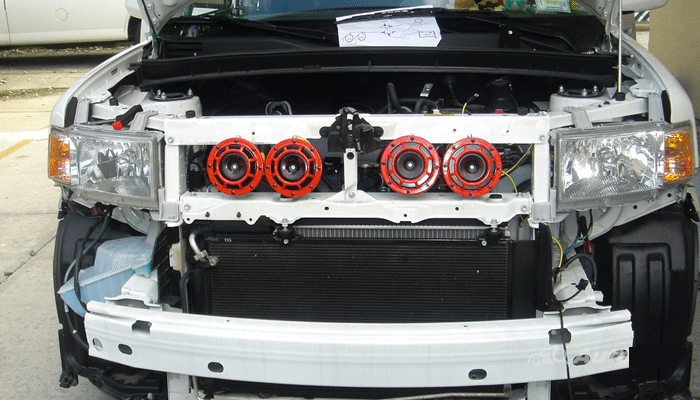
Your car’s horn is a safety feature that should never stop working. A weak or nonexistent horn can indicate problems such as a blown fuse, a broken clock spring under the steering wheel, or a faulty relay.
The easiest way to test the horn relay is to borrow a similar relay from another circuit on your vehicle and install it in place of the original. If the horn works, the old relay is defective.
Check the Horn Relay
The horn relay is located in the fuse box and controls the delivery of power to the horns. If the relay is faulty, your horn will not sound when you push the steering wheel horn button. A clicking noise may be heard when the relay contacts open and close, which is a good indication that it needs to be replaced.
Checking the horn relay is very easy. With the car’s power off, find the relay (usually by looking for a black box with a “horn” logo on it in the fuse box) and remove it. With a multimeter, set the voltmeter to read resistance and use it to determine if there is any continuity between the terminals on the relay. If there is no continuity or the voltmeter indicates that the relay has bad contacts, then it must be replaced.
Horn Relay Terminals
You can also try to jump the relay by connecting a wire from a nearby terminal on the vehicle to one of the horn relay terminals. If the horn works when you do this, it means that there is a problem further upstream from the horn relay.
Before jumping the relay, you should always inspect all electrical connectors to make sure they are clean and tight. This will help you determine if there is a problem with a wire that is not making contact, or a broken clock spring, which can cause the horn to fail to sound.
After replacing the horn relay and checking all connections, you should have a working horn system that meets the minimum state safety standards. However, if the horn still does not work, you should have it professionally diagnosed to determine what is causing the issue. An expert mechanic can track down the problem and repair it to return your horn to proper operation. You can contact a certified professional by using the YourMechanic mobile app or schedule an appointment at your local shop. A functional horn is important for your safety as well as the safety of other drivers on the road. A malfunctioning horn can also prevent your vehicle from passing state inspection, so don’t let it go untreated.
Check the Wiring
A functional horn is vitally important to your safety and that of other motorists. A failing horn may be the difference between avoiding a collision and not. It’s important to ensure that all connections are tight, wires are secure and fuses and relays are working correctly. This will require some tools, including a digital multimeter and jumper wires. If you want to upgrade your car’s wiring system at an affordable price, check out the Automotive Discount Code.
The first thing to check is whether or not there is a fuse or relay for the horn. This can often be found by looking at the fuse chart on the back of the fuse box or in your owner’s manual. If there is a fuse for the horn, the next step is to inspect it for a broken wire or bad connection.
Check the Horn Switch
If the fuse is OK, then the next thing to test is the horn switch. Usually, the horn switch is part of a larger stalk switch that includes several different functions. To test the horn switch, disconnect the wiring harness from the horn switch and connect a test lamp between the switch’s input terminal and the earth.
Alternatively, disconnect the red power wire from the horn and connect the red lead from your multimeter to the horn connector. Turn on the ignition and have a friend push the horn button.
Finally, if the horn relay is good and the switch and clock spring are OK, then the problem must be upstream from the switch or relay. This could be a blown fuse or a faulty relay or even the horn itself.
Replace the Horn
As with most of the electrical components in your car, the horn circuit has a fuse to protect it from overload. If a fuse blows, it cuts the circuit and renders your horn unusable.
Check the fuse chart in your owner’s manual to determine where the horn fuse is located and its proper rating. With the engine turned off, open the fuse box and pull out the horn fuse to check it.
If your horn is still unusable, the problem may be a bad clock spring. The clock spring connects the horn to the steering wheel and allows it to sound when the wheel is turned. A faulty clock spring may be preventing your horn from working because it’s unable to make contact with the horn contacts.
Many drivers decide to upgrade their horns for better sound quality or to fit a more powerful horn that is not available in the original equipment. In most cases, adding a second horn or changing the sound is fairly straightforward, but the current capacity of the wiring and switches must be able to handle the extra load. It’s a good idea to consult your vehicle’s owner’s manual or have the job done by an expert to avoid damaging the system. If you’re looking for a more affordable car horn, use the Automotive Promo Code.
Two Horn-connected Wires
If you want to do it yourself, it’s important to shut off the engine and disconnect the battery before starting any work on your horn. Remove the electrical connector and horn retaining fasteners, then disconnect the wire from the horn switch and use a multimeter to test for continuity between the two horn-connected wires.
If the horn isn’t getting a power supply, or the wires are damaged, the horn itself is probably blown. Luckily, it’s inexpensive and easy to have an independent repair shop or a dealer fix it for you. Alternatively, you can also buy replacement horns online or at a parts store and fit them yourself if you have mechanical skills.
The budget Horn Wiring System can be purchased using the DENALI Electronics Promotional. This system is an affordable option for those looking to upgrade their horn wiring. With the coupon code, you can save money on your purchase. The system is easy to install and will improve the functionality of your horn. Don’t miss out on this opportunity to upgrade your horn wiring system at a discounted price.
Test the Horn
A functional horn is vital for car safety. Especially when driving in busy traffic, you need to be able to honk if something comes up unexpectedly. If your horn is not working, you should fix it as soon as possible to avoid a collision. The main reason for a failing horn is a broken switch or power supply.
In most cases, the problem will be caused by dirty contacts or a poor connection. Clean the contacts with a wire brush and use a pair of small wire extensions to reach places that are hard to get to. Also, make sure that the horn switches have positive and negative contact.
Another common cause of horn problems is corrosion in the terminals. Use a wire brush or wipe to remove any rust from the connectors. This is especially important for the metal parts of the horn and the horn relay’s metal body.
If you don’t have a multimeter, you can check if the horn has power by connecting a test light between the horn and the earth. If the test light lights, the horn has power. Alternatively, you can use a multimeter to see if there’s battery voltage in the horn’s connector. Connect the meter probe to one of the pins of the relay connector and the other probe to the horn’s connector terminal. If the meter reads “out of limits” it’s time to replace the relay.
You can also try connecting the relay’s black contact to the horn’s ground terminal instead of the relay’s red contact. You can also test the horn itself by unplugging it and applying +12v direct to it. This will usually result in a loud smack, but be careful not to touch the diaphragm with your fingers or other metal objects.
Conclusion
The horn relay is located in the fuse box and controls the delivery of power to the horns. To test the horn switch, disconnect the wiring harness from the horn switch and connect a test lamp between the switch’s input terminal and the earth. Remove the electrical connector and horn retaining fasteners, then disconnect the wire from the horn switch and use a multimeter to test for continuity between the two horn-connected wires.








